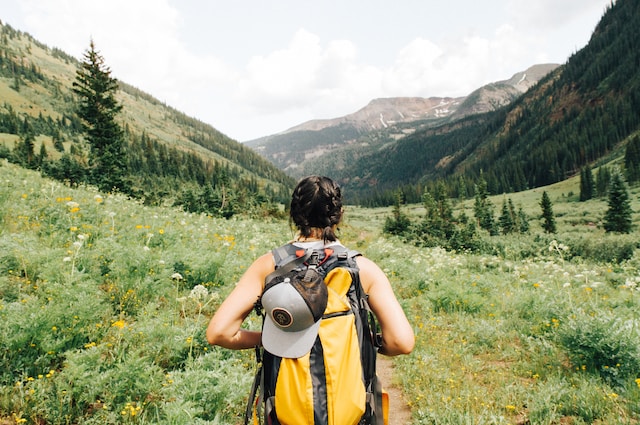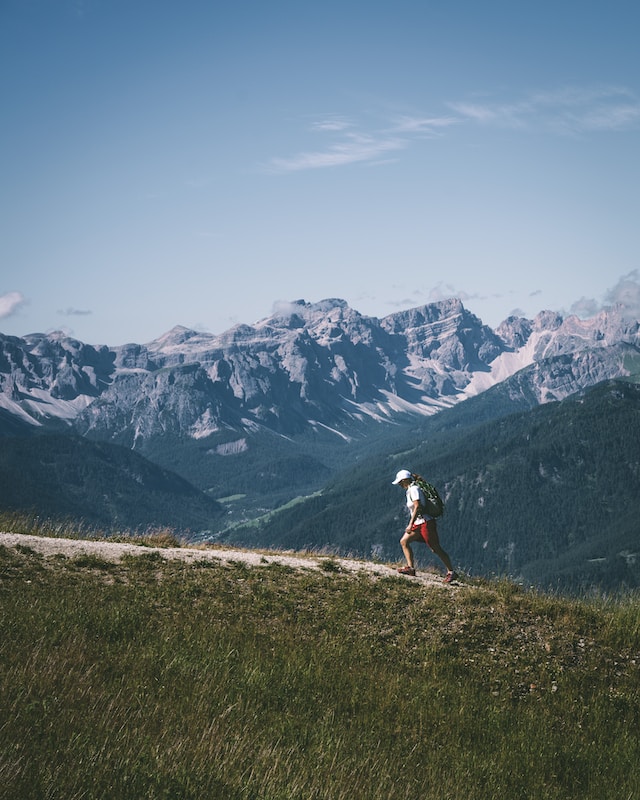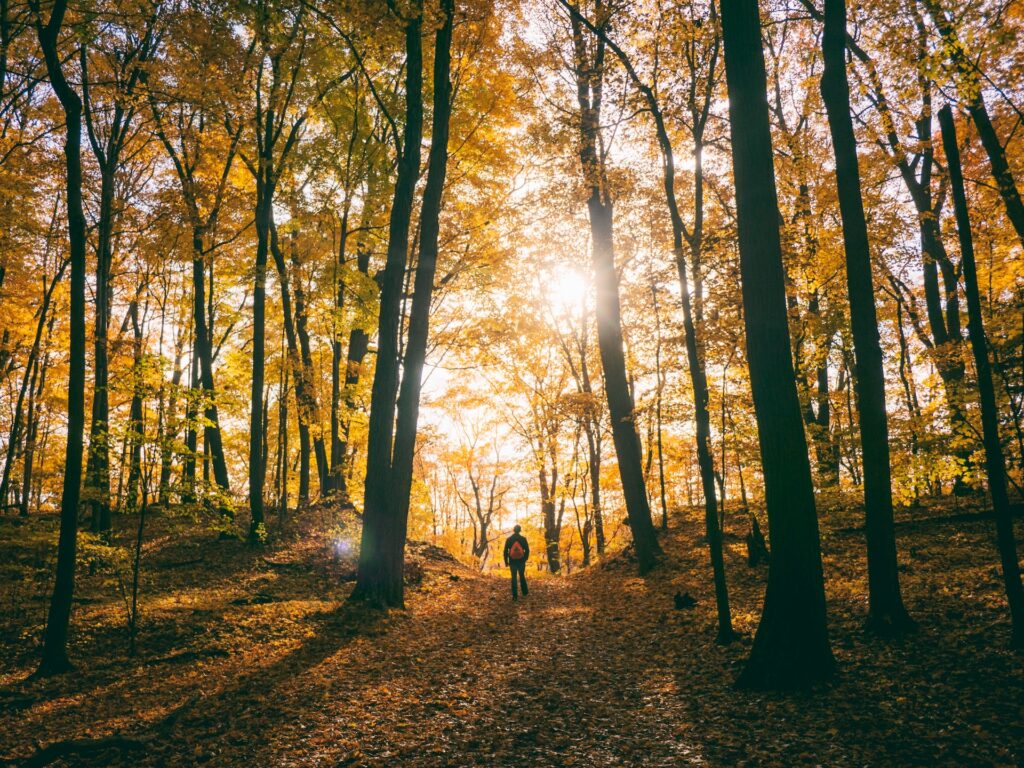I started hiking over a decade ago, and I’m very thankful I picked up this amazing hobby. Far too many people go through life without getting properly introduced to hiking and backpacking. And for those people, venturing with their friends and family into the wilderness can be quite scary – let alone doing it on their own! This is why I thought I’d share some of the safety tips for hiking alone that I learned over the years to inspire you to start hiking solo with confidence.
In this guide, we’ll talk about why you should try hiking alone, how to plan your first solo hike, and share some tips on how to do it safely so you can make the best out of your time on the trail.
Why Go Hiking Alone?
Hiking with your outdoorsy friends and family can be so much fun. You could even go hiking with local outdoor clubs you meet on social media or the MeetUp app. From personal experience, I can tell you this can be an excellent way to grow your social circle and enjoy your time in the backcountry. So why would you even consider hiking on your own, then? Well, solo hiking can be a great way to get exercise, connect with nature, and gain confidence in your abilities. It can also be a time for deep reflection and personal growth.
Freedom and flexibility
Hiking alone allows you to set your own pace, choose your own route, and take as many breaks as you like. You wanna spend an extra 10 minutes at the summit? Go for it, you won’t need to stick by the schedule of others who might have different plans. Saw a really interesting scene and the light is just right? Take as much time as you need to capture the perfect photograph without offending anyone else who might not have the patience for it.
Mental clarity and self-reflection
The solitude of solo hiking can be a great way to clear your head, process your thoughts, and gain a deeper understanding of yourself. Moreover, walking for hours in complete quietness and nothing but the sounds of nature can be quite relaxing.
Increased confidence and self-reliance
Solo hiking can help you build confidence in your abilities and independence. You’ll be responsible for navigating the trail, making decisions, and taking care of yourself. There won’t be someone to offer you a hand when crossing a challenging creek. You’ll need to rely on yourself and go for it (with caution, of course), and that’s how you become a better hiker.
Greater sense of accomplishment
Completing a tough hike in a group feels great, but completing a solo hike is on a whole different level of feeling amazing! It’s such a rewarding experience knowing that you’ve planned the trip, navigated the trail, and made it all the way to the finish line all by yourself!

Planning Your Solo Hike
If there’s one thing I’ve learned about hiking in general, and solo hiking in particular, is that proper planning is a key for a successful hike. Planning your outdoor adventure is going to give you an idea of what to expect in the wild. Accordingly, you can pack your backpack with everything you need and have a plan in case things go south.
Choose a well established trail
If this is your first time hiking solo, I would highly recommend you select a well maintained trail. The trail should preferably be part of a conservation project such as a national park. Take a look at the park’s website and pick a trail that aligns with your experience and physical abilities. Beginners should opt for well-marked, relatively short routes (around 2-3 hours) with minimal elevation gain.
I would even recommend you prioritize trails you’ve already hiked in the past if this is your first time hiking alone. And in all cases, make sure you thoroughly research the trail before heading out. This ensures you have a clear understanding of the trail’s conditions, potential hazards, and overall suitability for your solo adventure.
Check the weather
The weather forecast is never 100% accurate and cannot be fully trusted. But it’ll help you get a rough indication of how the conditions are likely going to be. I highly advise you to schedule your first solo hike on a day with good weather. Hiking in the rain can be an amazing experience, but it’s best to keep things easy and simple for your first time hiking alone.
Have an emergency plan
If you’re going to choose only one of my safety tips for hiking alone, I would recommend you choose this one. You never know what might go wrong, so it’s important that you be prepared for the worst. I’m not trying to scare you away, but rather make sure you return home safely in case things go south.
Tell someone where you’re going
Inform someone of your solo hiking plans, including your intended trail, expected return time, and emergency contact information. Also, let them know you’ll call them when you return back home – and make sure you do that! If they do not hear from you, they can call for a search and rescue mission for you.
Pack the 10 essentials
There are things you should always remember to bring on a hike, no matter how long or short the trail might be. I have talked about this in details in my guide on how to pack for a day hike, but I’ll summarize the list here again:
- Bring enough water: you want at least 0.5 liter of water for each hour of hiking.
- Bring enough food: pack more food than you think you need. In addition to your main meal, bring a bunch of nutrient rich snacks such as trail mix, energy/protein bars, nuts and dried fruits.
- First aid kit: always have a first aid kit in your backpack. It’ll help you take care of common injuries that do not require a medical professional.
- Navigation tools: your phone is an excellent navigation tool as long as it has battery, so make sure you switch on airplane mode. But, your phone might break so it’s crucial that you carry a compass and a physical topographic map as backup.
- Pack a headlamp: if you end up staying in the wild when it gets dark, a headlamp will help you find your way on the trail. And no, your phone’s torchlight is not good enough.
- Pack an emergency shelter: a space blanket would fit perfectly at the bottom of your pack. You’ll pat yourself on the back for it if you end up stranded overnight.
- Pack a multi-tools set / knife: this will come in handy if you need to temporarily patch up your gear.
- Bring something to start a fire: a butane lighter and some sort of a firestarter are recommended.
- Pack extra clothes: always pack one or two extra layers of clothes because weather conditions might change at any time. In addition to a rain jacket, consider a fleece pullover and an extra pair of merino wool socks.
- Protect yourself from the sun: you need to protect your eyes and skin from UV light. An SPF-30 sunscreen and a pair of sunglasses can help you with that.
Learn what to do in a wildlife encounter
Research the area where you will be hiking and be aware of potential wildlife encounters. By staying calm, understanding animal behavior, and taking the appropriate precautions, you can safely navigate these situations.
Stay calm and avoid sudden movements. Abrupt movements or loud noises can startle animals and trigger defensive reactions. Make noise to alert the animal of your presence by speaking calmly or clapping your hands. Provide ample space for the animal to pass or retreat and avoid eye contact. In case you’re hiking in bear country, consider carrying bear spray and using it as a last resort if the bear charges you.

5 Safety Tips for Hiking Alone
Hiking solo requires extra caution and discipline on the trail to ensure you return back to civilization safely.
Stay on the trail
The number one reason why people get lost while hiking is because they accidentally lose the trail. Make sure you use the navigation tools at your disposal to stay on track. Also, pay attention to trail signs if this is an established hike, or the colored marks left by previous hikers on rocks and trees. These will help you know you’re still on the right path. Otherwise, backtrack your steps to the last point where you’ve seen them.
Be aware of your surroundings
It’s important that you stay alert on the trail. You want to be aware of any wildlife, falling rocks or trees or anything that might compromise your safety. With that said, I would recommend you avoid using your earphones to listen to music. Or, at least keep the volume down and preferably use only one earbud so you can still hear what’s going on around you.
Trust your gut feeling
When hiking alone, your top priority should be your safety. If you feel something isn’t right, trust your instincts and do what feels right for you. I’m not saying you should be paranoid on the trail, but rather extra vigilant and cautious.
Be prepared to turn around
Following on the note of trusting your gut, if you feel it’s getting late or not sure whether you’re still moving in the right direction, stop and reassess the situation. Feeling too tired and don’t feel like you can make it to the finish line? Feel like this creek is a bit too dangerous to cross and you’re not confident of your physical abilities? It’s perfectly okay to turn around and call it a day. Just take the win and be proud that you got yourself out there. You’ll get better and feel more confident as you do it more often.
Use technology to your advantage
Technology can play a crucial role in enhancing safety during solo hikes. Consider using navigation apps that provide you the option of downloading maps for offline use. I highly recommend the AllTrails Pro and Gaia GPS apps. Either of them is an affordable investment I would encourage you to make to ensure your safety when hiking alone (or with partners).
Another item I always carry in my backpack is a power bank. My phone is of no use to me if it runs out of battery, so it’s important that I have at least an extra couple of charges with me at all time.
Additionally, you might want to carry a dedicated GPS tracking device which could either be a handheld unit or a GPS smartwatch. Similarly, one item that could literally be a life saver if you get injured or lost is a 2-way satellite communicator. This allows you to send text messages to your friends and family without cellular connectivity. And in case something goes wrong, you can send an SOS signal to emergency teams in the area.

Final Thoughts on Hiking Alone Safely
If you’ve never gone hiking before, I do not recommend you start hiking solo. Instead, do it within a group first so you can get a feel for what it’s like to be away from civilization. Once you’ve done it a few times with the guidance of someone with more experience, then it’s time to make use of the safety tips for hiking alone I’ve shared in this guide. After a few solo hikes you’ll feel a lot more comfortable hiking by yourself. I would even go as far as to say this might become you’re preferred way of hiking!
Do you prefer hiking alone or with friends and family? Share your thoughts and experiences in the comments.
